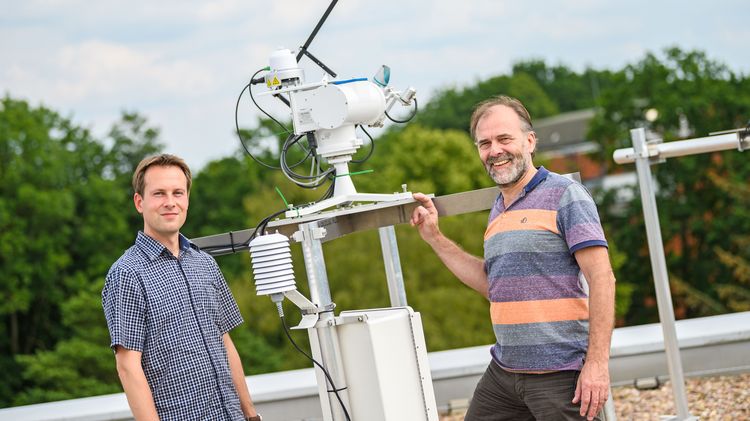Mapping the wind
Mapping the wind
Mapping the wind
Energy meteorologists like Detlev Heinemann work on determining and predicting wind flows for wind farms or larger regions. Thanks to such forecasts, amongst others, experts are constantly getting better at calculating wind yields.
The eternal wanderer, the dragon with a thousand tails, the swirling dancer: the dynamic nature and power of the wind has inspired many pretty metaphors over time. But what makes atmospheric air flow so fascinating to poets is an on-going problem for physicists and meteorologists: the motion of air in the first 200 metres above the ground is so variable that it is virtually impossible to predict it using equations, approximations and model calculations.
This is a problem for the wind energy industry – and the energy turnaround: It is difficult to plan, when and how much wind power is available. The source for renewable energy is considered notoriously unreliable. Energy meteorologist Dr. Detlev Heinemann from the Center for Wind Energy Research ForWind at the University of Oldenburg and his team work on overcoming this problem: they calculate average wind speeds, maximum values and other important weather data to facilitate planning.
An atlas for wind power
Wind resource assessment plays a key role in the planning of wind farms. Until now project developers have had to rely on data from the 1980s that produced viable results only for flattish terrain like northern Germany. In the kind of hilly or mountainous terrain where a growing number of new wind farms are now being built this model has failed.
This means that until now there has been no way to reliably predict the energy yield of wind farms located outside flat terrain. Again and again, wind farm operators have ended up in financial difficulties due to planning errors. “If you make a rough calculation of the yields and the average wind speed differs from the estimate by just 0.2 metres per second, it can cost a large wind farm with 50 turbines up to five million euros – per year!” Heinemann explains.
Since June 2019, however, planners have had access to better data: the New European Wind Atlas (NEWA) now provides accurate information on wind strength at any location within the European Union as well as the North and Baltic Seas in the last thirty years. Heinemann and his colleague Dr. Björn Witha were key participants in this international project, which had a budget of approximately 13 million euros. “Our goal was to provide detailed, long-term data about the wind climate across Europe,” says Witha.
Extensive preparatory work
Launched in 2015 and led by the Technical University of Denmark in Roskilde, around thirty institutions from eight countries participated in the mammoth project. The objective was to create a virtual grid with a three-kilometre grid spacing that spanned the entire continent, and to generate complete time-series wind datasets for the last 30 years at each node.
Users would, for example, be able to call up data on the average wind speed, maximum wind speed or temperature for any given day – for heights between ten and 500 metres above ground and 30-minute intervals. For an even tighter network with a grid spacing of 50 metres, the goal was to provide at least statistical data on variables such as the frequency of specific wind speeds and directions.
The researchers had to make all these calculations on their own. They did this using a computer model commonly used for weather forecasting into which they fed the relevant weather data to determine the values at the nodes. “We couldn't just press a button and start calculating; we had to do extensive preparatory work,” says Witha, who was largely responsible for designing and coordinating the tests.
Free access to interactive maps
The team tested different versions of the model to determine the optimum configuration. The researchers also examined how the selection of different physical parameters affected the results and compared the results with measurements made during four measurement campaigns conducted specifically for the project at several test sites.
Most of the preparatory model calculations were performed on the University of Oldenburg's high-performance computing cluster, which has specifically been made available for wind energy research. For the simulations which ultimately provided the data for the Wind Atlas, the team resorted to the even greater computing capacity of the Mare Nostrum supercomputer at the University of Barcelona. Even so, the calculations took more than half a year – a standard PC would have needed around 1,600 years to complete this task.
The Wind Atlas's new website now offers free access to interactive maps, time-series and wind-speed statistics, and other relevant parameters for wind power. “The scope and resolution of NEWA are unique,” Witha says. After publication the data quickly started generating a lot of attention, he adds.
There are many interesting things to discover – for example that the wind blows less in cities like Oldenburg than in the surrounding area, that the Brocken in the Harz mountain range is the windiest location on the German mainland, and that there is almost no wind at all in the Po Valley in northern Italy. Consulting engineers can use the website to gather all the data they need to plan a wind farm. And government authorities, farmers and water sports enthusiasts also benefit from the information it provides.



